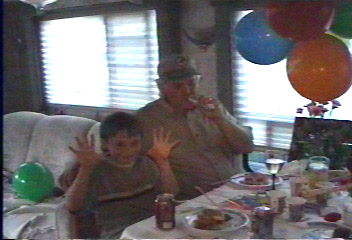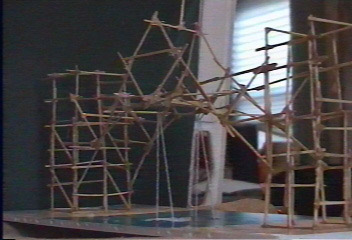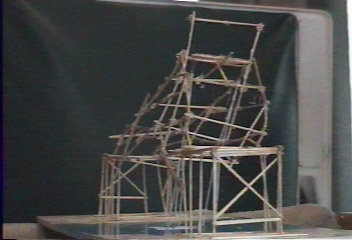Two years of traveling and we finally see the Atlantic!
September, 2000
Niagara Falls, New York
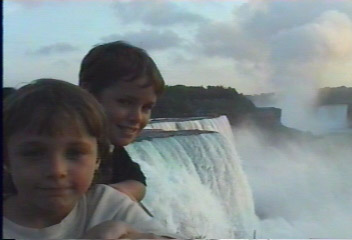 |
Well, we're almost to the Atlantic, but first a few more
stops.
Niagara Falls was impressive -- a column of mist
rises from Horseshoe Falls in the background. This was the first
image we saw as we approached the falls. The cloud of mist rises
high in the sky. In the winter this must produce a lot of snow nearby.
Next, we crossed a bridge into the New York State Park where Niagara Falls
is located. |
The river behind the falls races by at thirty miles an hour
or more. There are several ten foot drops. The excitement to
see the falls was building. Down stream we could see where the river
drops out of sight. The falls, (behind the boys in the photo above), is
the American Falls. Just past the mist is Bridal Veil Falls.
There used to be a trail that took you to a cave -- The
Cave Of The Winds -- right under the falls. However, many years ago
the roof collapsed, so now the cave is closed. They still use the
original trail, but now it takes tourists, (us included), down by the cave
and right up against the bottom of the waterfall. It's real windy
at the bottom of the trail as the water pushes the air all around -- (you
can barely see the wooden platform in the mist.)
| The deck has water coming over the top of it with bursts
of water and spray. It was real easy to imagine that we were standing
on a large sailing ship caught in a hurricane. (Gee, maybe that's
why they call this the "Hurricane Deck.") Even with the yellow
slickers on we all got quite wet. We attempted to take photos from
the deck but there was so much wind and water that it was hopeless.
I took the photo on the right from the Maid of the Mist, a boat ride that
goes near the bottom of Horseshoe Falls. |
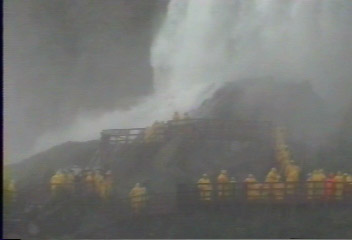 |
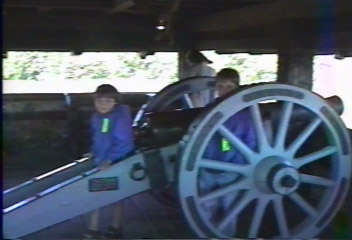 |
Down river from the falls is Fort Niagara, a National
Historic Landmark. It's near Youngstown, New York on the Niagara
River at the mouth of Lake Ontario.
Back in 1679 this was an important piece of real estate
-- whoever controlled this spot, (first the French, then the English,
and finally the Americans), also controlled the only shipping lane to the
interior lakes and waterways. |
| The French established the first post here in 1679 and
40 years later built much of the fort that stands today. Britain
gained control in 1759 during the French and Indian War. The British
held the fort throughout the Revolution but were forced, by treaty, to
turn it over to the United States in 1796. The British recaptured
the fort in 1813. It was ceded to the the US a second time in 1815
after the war of 1812.
Here's a picture of the crank and counter weight for the
drawbridge on the castle built by the French in 1726.
Since we're from the west, we used to be impressed with
historic sites with dates in the late 1800's. Now that doesn't seem
so long ago. |
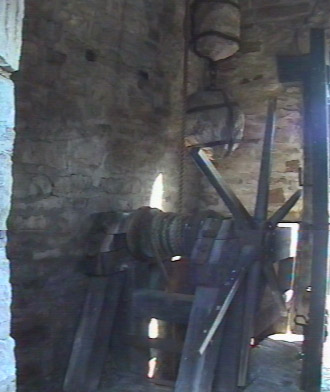 |
The Erie Canal
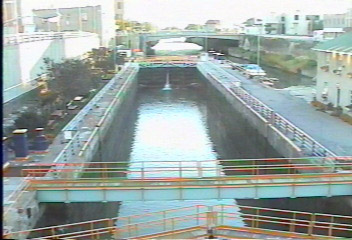 |
I don't remember the specifics, but here at Lockport
New York, the Erie Canal rises 100 to 150 feet. There are a series
of four locks here with three of them right behind me. Prior to the
railroad, the east coast had hundreds and hundreds of miles canals and
locks.
The Erie is still in use today. We talked with
a couple on a small cruiser that were going through the locks. They
said it cost them $15 to go through all of the locks from Lake Erie to
the Hudson River, (i.e. New York City). |
Corning, New York
| We toured the Corning Glass
Museum. We learned about the history of glass, how it is made
and its past, present and future uses.
Since he's learned how glass used to be made, Mitch likes
to check older looking houses and buildings for window panes made the old
fashioned way. The glass makers used to spin it like pizza dough
and then cut out rectangles from the round sheets.
|
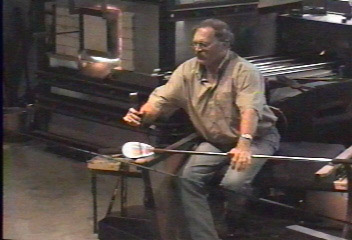 |
This museum houses a great collection of glass utensils,
art and furniture from around the world and of the ages. They also have
great "hands-on" glass technology displays -- ones on lenses, mirrors and
fiber optics.
I'd be fun to come back one summer and take one of Corning's
week long classes on glass blowing.
Next stop: Easton, Pennsylvania, and the Crayola
Factory. The actual Crayola factory is ten miles out of town and
not open to the public, but there's a nice visitor and activity center
in the heart of town.
Easton is a very quaint town. The buildings are
all over 100 years old or built to match the older style. Most midwest
and eastern towns have a town square or plaza area, and Easton is no exception.
Next to the Crayola building was Bixler's Jewelry. They have been
in business here since 1785.
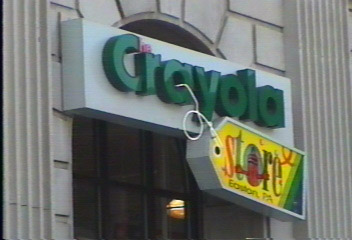 |
The third floor of this building houses a museum on canals
and canal boats. Since we had just visited the Erie Canal this was
an interesting display and we learned a lot about the history of transporting
goods in this country. OK, so back to the crayons ...
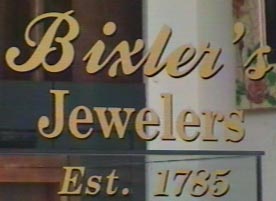 
|
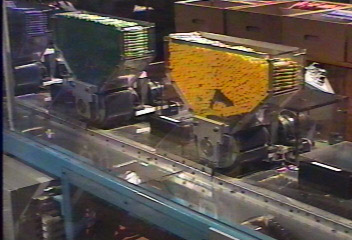 |
You probably don't remember crayons in boxes like the
ones above. They go back to 1903 through 1934. We watched how
the crayon material is melted, poured into the molds and then dropped out.
Each mold produces 1200 crayons. From there they are placed in the
wrapper machine and then boxed. This is a picture of the machine
that packs boxes of four colors used in restaurants. |
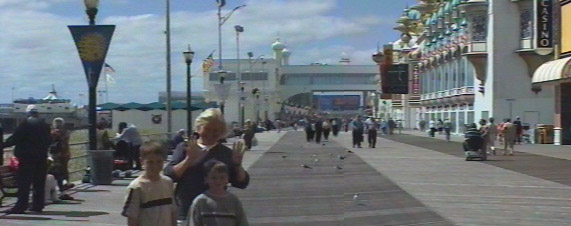
Atlantic City, New Jersey -- on the Boardwalk
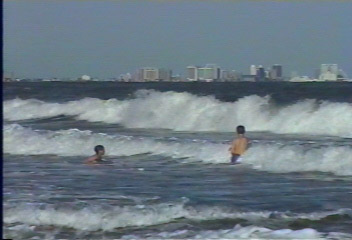 |
The boys were glad to do a little boogie boarding again
-- (that's Atlantic City in the background). Though we had a lot
of fun on the New Jersey coast, we didn't think much of Atlantic City.
Other than the boardwalk and a strip of casinos, there's not much here.
Crime is high and the rest of downtown is pretty run down.
There is an almost gaudy look to the place -- old, brick
buildings that are badly in need of repair, right across the street from
huge, flashy casinos. And everywhere, buses full of very elderly people
looking for the buffets. |
I said "there's only senior citizens here". Cheryl
replied, "no, they're all much older than that." We figured that
the casinos must give them all a free bus ride and buffet coupon.
Most of them appeared to be from upstate New Jersey or New York on a one-day
excursion.
Max enjoyed his 9th birthday. I got the boys out of
the house and Cheryl decorated the trailer. When we got back home
from Atlantic City, Max was the first one in and found the place ready
for a celebration.
The Bridge Building Competition
The boys built these bridges out of toothpicks and glue over
several days. They had design specifications for the height and width
of the ship that would sail under the bridge and the width and height of
the vehicles that would travel on the bridge deck. They also had
to keep track of material purchases for each days activities. Then
they were judged on meeting the specs, overall costs, bookkeeping and structural
strength.
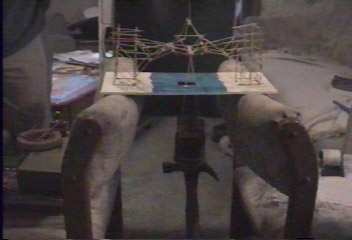 |
The bridge on the upper left is under a large load.
On the upper right you can see the load system. The bridge spans
the two mountainous chairs and weights are hung below an opening in "the
river".
We had four rolls of quarters, a large speaker magnet
and a hammer on Mitch's bridge before it finally gave way. |
ã
copyright Nodland 1999-2020













